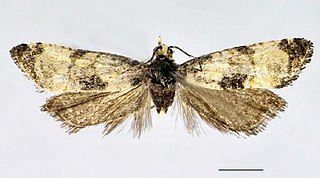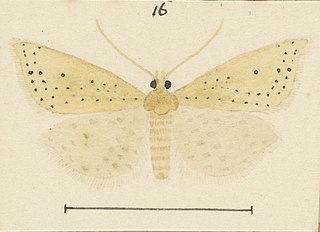
The Archipini are a tribe of tortrix moths. Since many genera of these are not yet assigned to tribes, the genus list presented here is provisional.

Merophyas divulsana, also known as the lucerne leaf roller, is a species of moth of the family Tortricidae. It is found throughout Australia and has also been spotted in New Zealand.

Merophyas is a genus of moths belonging to the subfamily Tortricinae of the family Tortricidae. In December 2015 it was sunk as a synonym of Clepsis Guenée, 1845.

Ochetarcha is a genus of moths belonging to the subfamily Tortricinae of the family Tortricidae. It contains only one described species, Ochetarcha miraculosa, also known as the ponga stem borer, which is found in New Zealand.

Philedone is a genus of moths belonging to the subfamily Tortricinae of the family Tortricidae. It contains only one species, Philedone gerningana, the cinquefoil tortrix or cinquefoil twist, which is found in Asia and Europe. It was first described by the Austrian lepidopterists Michael Denis and Ignaz Schiffermüller in 1775.

Apotomis betuletana is a moth of the family Tortricidae. It is found in most of Europe. It is also found in the eastern part of the Palearctic realm. The habitat consists of woods and woodland margins where birch occurs.

Cochylis roseana is a moth of the family Tortricidae. It is found in most of Europe, Uralsk, Iran, Asia Minor and China (Gansu).

Cochylichroa atricapitana, the black-headed conch, is a moth of the family Tortricidae. It is found in China (Xinjiang) and the eastern Palearctic and most of Europe.

Cochylis dubitana, the little conch, is a moth of the family Tortricidae. It is found in China (Heilongjiang) and most of Europe. and the Caucasus. It is also found in North America, where it has been recorded from Colorado, Maine, Ontario and Washington.
Epichorista crypsidora is a species of moth of the family Tortricidae. It is found in New Zealand.

Epichorista elephantina is a species of moth of the family Tortricidae. It is found in New Zealand.

Epichorista zatrophana is a species of moth of the family Tortricidae. It is found in New Zealand.

Epichorista siriana is a species of moth of the family Tortricidae. It is found in New Zealand.

Gelophaula trisulca is a species of moth of the family Tortricidae. It is found in New Zealand.
Eurythecta phaeoxyla is a species of moth of the family Tortricidae. It is found in New Zealand. The habitat consists of swampy areas.

Harmologa oblongana is a species of moth of the family Tortricidae. It is found in New Zealand.
Merophyas siniodes is a species of moth of the family Tortricidae. It is found in Australia, where it has been recorded from South Australia.

Merophyas leucaniana is a species of moth of the family Tortricidae. It is found in New Zealand.

Pyrgotis eudorana is a species of moth of the family Tortricidae. It is endemic in New Zealand and has been observed in both the North and South Islands. However it is regarded as a rare insect. This species inhabits native forest. Larvae exclusively feed on Muehlenbeckia australis and adults are on the wing from November to April. Adults are attracted to light.
Zacorisca phaeoxesta is a species of moth of the family Tortricidae. It is found on New Guinea and on Seram.















